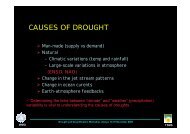training course on weather radar systems - RTC, Regional Training ...
training course on weather radar systems - RTC, Regional Training ...
training course on weather radar systems - RTC, Regional Training ...
- No tags were found...
You also want an ePaper? Increase the reach of your titles
YUMPU automatically turns print PDFs into web optimized ePapers that Google loves.
MODULE A- INTRODUCTION TO RADAR<br />
K: This is a physical c<strong>on</strong>stant. This is a known value of the <strong>radar</strong>. This c<strong>on</strong>stant relies <strong>on</strong> the<br />
dielectric c<strong>on</strong>stant of water. This is an assumpti<strong>on</strong> that has to be made but also can cause some<br />
problems. The dielectric c<strong>on</strong>stant of water is near <strong>on</strong>e, meaning it has a good reflectivity. The<br />
problem occurs when you have meteorological targets that do not share that reflectivity. Some<br />
examples of this are snow and dry hail since their c<strong>on</strong>stants are around 0.2.<br />
L: This is the loss factor of the <strong>radar</strong>. This is a value that is calculated to compensate for attenuati<strong>on</strong><br />
by precipitati<strong>on</strong>, atmospheric gases, and receiver detecti<strong>on</strong> limitati<strong>on</strong>s. The attenuati<strong>on</strong> by<br />
precipitati<strong>on</strong> is a functi<strong>on</strong> of precipitati<strong>on</strong> intensity and wavelength. For atmospheric gases, it is a<br />
functi<strong>on</strong> of elevati<strong>on</strong> angle, range, and wavelength. Since all of these accounts for a 2dB loss, all<br />
signals are strengthened by 2 dB.<br />
λ: This is the wavelength of the transmitted energy. This is a known value of the <strong>radar</strong>. The amount<br />
of power returned from a precipitati<strong>on</strong> target is inversely since the short wavelengths are subject to<br />
significant attenuati<strong>on</strong>. The l<strong>on</strong>ger the wavelength, the less attenuati<strong>on</strong> caused by precipitate.<br />
Z: This is the reflectivity factor of the precipitate. This is the value that is solved for mathematically<br />
by the <strong>radar</strong>. The number of drops and the size of the drops affect this value. This value can cause<br />
problems because the <strong>radar</strong> cannot determine the size of the precipitate. The size is important since<br />
the reflectivity factor of a precipitati<strong>on</strong> target is determined by raising each drop diameter in the<br />
sample volume to the sixth power and then summing all those values together. A ¼" drop reflects<br />
the same amount of energy as 64 1/8" drops even though there is 729 times more liquid in the 1/8"<br />
drops.<br />
R: This is the target range of the precipitate. This value can be calculated by measuring the time it<br />
takes the signal to return. The range is important since the average power return from a target is<br />
inversely related to the square of its range from the <strong>radar</strong>. The <strong>radar</strong> has to normalize the power<br />
returned to compensate for the range attenuati<strong>on</strong>.<br />
Using a relati<strong>on</strong>ship between Z and R, an estimate of rainfall can be achieved. A base equati<strong>on</strong> that<br />
can be used to do this is Z=200*R 1.6 . This equati<strong>on</strong> can be modified at the user's request to a better<br />
fitting equati<strong>on</strong> for the day or the area.<br />
TURKEY RADAR TRAINING 1.0 / ALANYA 2005 11
















